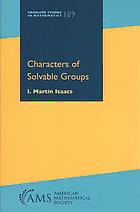
Characters of solvable groups PDF
Preview Characters of solvable groups
GRADUATE STUDIES 189 IN MATHEMATICS (cid:39)(cid:76)(cid:69)(cid:86)(cid:69)(cid:71)(cid:88)(cid:73)(cid:86)(cid:87)(cid:3)(cid:83)(cid:74)(cid:3) Solvable Groups I. Martin Isaacs Characters of Solvable Groups GRADUATE STUDIES 189 IN MATHEMATICS Characters of Solvable Groups I. Martin Isaacs EDITORIAL COMMITTEE Dan Abramovich Daniel S. Freed (Chair) Gigliola Staffilani Jeff A. Viaclovsky 2010 Mathematics Subject Classification. Primary 20C15; Secondary 20C20, 20D10, 20D35, 20F16, 20F14. For additional informationand updates on this book, visit www.ams.org/bookpages/gsm-189 Library of Congress Cataloging-in-Publication Data Names: Isaacs,I.Martin,1940–author. Title: Charactersofsolvablegroups/I.MartinIsaacs. Othertitles: Solvablegroups Description: Providence,RhodeIsland: AmericanMathematicalSociety,[2018]|Series: Gradu- atestudiesinmathematics;volume189|Includesbibliographicalreferencesandindex. Identifiers: LCCN2017047819|ISBN9781470434854(alk. paper) Subjects: LCSH: Solvable groups. | Group theory. | AMS: Group theory and generalizations – Representation theory of groups – Ordinary representations and characters. msc | Group theory and generalizations – Representation theory of groups – Modular representations and characters. msc|Grouptheoryandgeneralizations–Abstractfinitegroups–Solvablegroups, theory of formations, Schunck classes, Fitting classes, π-length, ranks. msc | Group theory andgeneralizations–Abstractfinitegroups–Subnormalsubgroups. msc|Grouptheoryand generalizations – Special aspects of infinite or finite groups – Solvable groups, supersolvable groups. msc|Grouptheoryandgeneralizations–Specialaspectsofinfiniteorfinitegroups– Derivedseries,centralseries,andgeneralizations. msc Classification: LCCQA177.I83252018|DDC512/.2—dc23 LCrecordavailableathttps://lccn.loc.gov/2017047819 Copying and reprinting. Individual readersofthispublication,andnonprofit librariesacting for them, are permitted to make fair use of the material, such as to copy select pages for use in teaching or research. Permission is granted to quote brief passages from this publication in reviews,providedthecustomaryacknowledgmentofthesourceisgiven. Republication,systematiccopying,ormultiplereproductionofanymaterialinthispublication ispermittedonlyunderlicensefromtheAmericanMathematicalSociety. Requestsforpermission toreuseportionsofAMSpublicationcontentarehandledbytheCopyrightClearanceCenter. For moreinformation,pleasevisitwww.ams.org/publications/pubpermissions. Sendrequestsfortranslationrightsandlicensedreprintstoreprint-permission@ams.org. (cid:2)c 2018bytheauthor. Allrightsreserved. PrintedintheUnitedStatesofAmerica. (cid:2)∞ Thepaperusedinthisbookisacid-freeandfallswithintheguidelines establishedtoensurepermanenceanddurability. VisittheAMShomepageathttp://www.ams.org/ 10987654321 232221201918 To Deborah Contents Preface ix Part 1. π-Theory Chapter 1. π-Separable Groups and Character Theory Background 3 Chapter 2. π-Special Characters 25 Chapter 3. Partial Characters 67 Chapter 4. The Nucleus and B -Characters 95 π Chapter 5. B (G) and I (G) 131 π π Part 2. Character Counts and Correspondences Chapter 6. The Okuyama–Wajima Argument 173 Chapter 7. Fully Ramified Abelian Sections 209 Chapter 8. Fully Ramified Sections and Character Correspondences 245 Part 3. M-Groups Chapter 9. M-Groups and Monomial Characters 287 Chapter 10. Symplectic Modules and Character Theory 311 Bibliography 359 Index 363 vii Preface When character theory was developed at the end of the 19th century and in the early years of the 20th, it was viewed primarily as a powerful technique for proving theorems about finite groups. For example, Burnside’s paqb- theorem and Frobenius’s theorem on the existence of what we now call Frobenius kernels were early triumphs of the use of character theory as a tool for proving group-theory theorems. Indeed, characters continued to play an essential role in proving theorems about groups for another 50 years or so, culminating in the Feit–Thompson odd-order theorem. Another thread in the development of character theory is the establish- ment of connections between the characters and the subgroup structure of a group. Examples of this are Brauer’s theorem on induced characters, which asserts that every character of G is a Z-linear combination of characters induced from certain nilpotent subgroups, and also the Itˆo–Michler theo- rem, which gives a necessary and sufficient condition in terms of irreducible character degrees for G to have a normal abelian Sylow p-subgroup. Researchontheconnectionsbetweencharactersandsubgroupscontinues unabated, and there are still a number of intriguing open questions in this area. For example, consider the still-unresolved McKay conjecture, which posits that for each finite group G and each prime number p, the numbers of irreducible characters with degrees not divisible by p of G and of the normalizer of a Sylow p-subgroup of G are equal. Within the last half century or so, there has been considerable atten- tion paid to the character theory of groups such as solvable and p-solvable groups that have an abundance of normal subgroups. One reason for this is that groups of this type often serve to motivate and to “test” more general questions. For example, the Itoˆ–Michler theorem was initially proved (by ix
